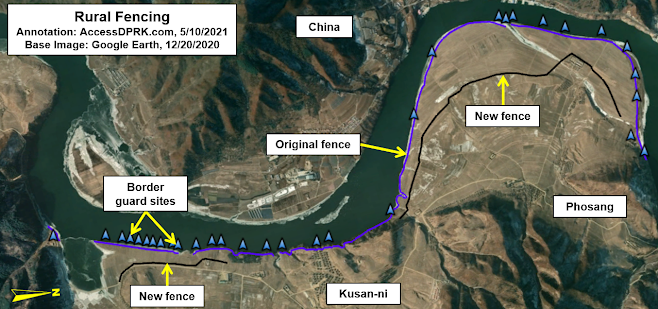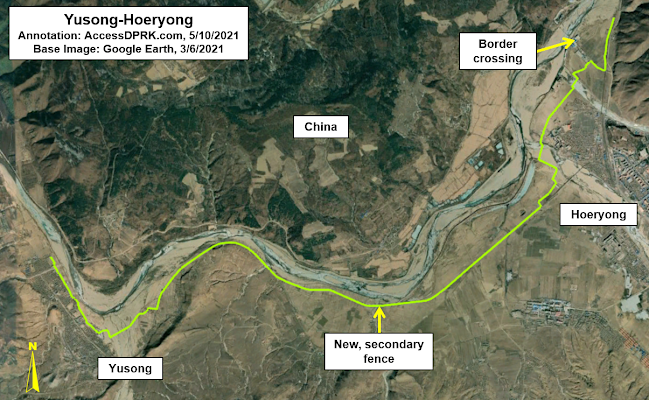North Korea has always been a relatively closed country, and casual international travel has never been an option for the population. Thus, the state has taken numerous measures to close off their border with China to prevent illegal trade, defections, and to limit the spread of outside information.
Major events have led to the breakdown of this system as local soldiers and police became susceptible to bribes and internal pressures meant citizens were emboldened to cross the border to earn a livelihood (and a relative few to escape). One such event was the famine of 1994-98. During this time Kim Jong Il attempted to tighten border controls and drastically limit internal travel as well. One of these projects was a national fence system that integrated border security with cutting access to the sea, to prevent illegal fishing and defections via boat.
Kim Jong Un reinvigorated these measures and has been very successful in cutting down the number of defectors; although, less successful at stopping illegal trade. He has also renovated poorly maintained sections of the coastal fence.
The biggest changes, however, have taken place at the Chinese border. Extra guard posts, cameras, signal jammers and other technologies to track and interfere with cross-border communications have all been added. Those, along with enhanced punishments for police and border guards who allow themselves to be bribed, have cut defections down to the lowest levels since before the famine.
However, the latest attempts to control the Sino-DPRK border go well beyond anything we have seen before. The intersection of the government's desire to gain greater control over market activity by limiting illicit trade and its perceived need to hermetically seal the country away from the world to keep COVID-19 from ravaging the nation, has led to border cities practically being turned into their own prisons.
As first described by AllSource Analysis, cities like Hoeryong have had a double layer of (likely electrified) fencing added, the number of guard posts has dramatically increased, and even farmers must now pass through checkpoints in order to access their fields near the border.
Up and down the Sino-DPRK border, these additions that have collectively been referred to as a "border blockade", can be verified through commercial satellite imagery.
The city of Wiwon (40.892144° 125.965411°) is one such county seat where new fencing and guard posts can easily be seen.
Fencing does not run the full length of the border. In many places, like Wiwon, dams create wide and deep reservoirs along the Yalu River and the outflow of the dams mean that the river doesn't freeze over in winter - preventing an easy walk across. Additionally at Wiwon, there is no riverfront road. The only road leads south, away from the border. Thus, the only way to get away from the active patrols of police in the city is to walk through forests and mountains in the hopes of finding a better spot to cross.
These natural obstacles are no longer deemed sufficient. In late 2020, the poorly maintained partial fence that had existed was rebuilt and extended across the whole town's riverfront area.
Added border controls have also popped up in much more rural areas, like at the villages of Kosan-ni and Phosang, 20 km upriver from Wiwon.
To access the land in between the two fences, farmers must now pass through checkpoints. The new fence is not yet complete and new sections and guard sites are being built. The largest chunk of land in this one area cut off from easy farming is approximately 126 hectares (311 acres). While this doesn't prevent the land from being farmed, it does make the process even more difficult and makes it harder for the lowest class of citizen to engage in trading activities.
The regime has even added security in cities where security and surveillance is already strong. Manpo is a border city with an official border crossing. It is also home to important chemical and industrial facilities which necessitate higher security on their own.
Manpo has a levee to protect it from a flooding Yalu and has border guard posts built on top. There are also guards and police deployed along the border crossing and in the hills that encircle the city. Regardless of these controls, a second fence line was added just a few meters behind the already secured levee.
The cities of Yusong and Hoeryong, which lie on the Tumen River, have been fenced off together to form a single security area.
There have been 14 km of new fencing built connecting the cities. The new fence ties into the main line of border fence at each end which are then anchored by hills next to Yusong and Hoeryong, preventing people from crossing the Tumen in this area.
The new fence here also follows the path of the railway, something it does in other areas as well. This provides the added security effect of keeping people from being able to jump on or off trains in an attempt to circumvent internal security checkpoints and train stations, where travel documents must be examined.
In 2018, the AccessDPRK database only had eleven identified guard posts along this same area; roughly one for every 1.2 km. With these new changes, including additional posts on the first fence and the ones associated with the second fence, there are posts every 60-100 meters with some as close together as 40 meters. For both fences combined, that's anywhere from 280 guard posts (one for every 100 m) to 466 (if one for every 60 m).
There have been DailyNK reports that even the regular army has been brought into some of these areas to help build the fencing and man its positions. However, I do not think that every single guard post will permanently remain manned. I think they will serve more as a deterrent, as any one could have an armed soldier in it and the locals won't know which ones do or don't at any given time.
If I can interject some personal feelings, I find the additional fencing and guard posts at Yusong and Hoeryong even more tragic, as this area has been the victim of two major floods in just five years. The sense of helplessness among the people at seeing the new construction - that they can't leave a very dangerous area or stock up on traded goods in the event of another disaster - must have been palpable.
Pyongyang may be determined to put an end to defections (something they're very close to doing) and they are desperate to prevent the spread of COVID-19, the country is equally desperate to resume importing goods from China. COVID-19 has wrecked the national economy and it has been speculated that the government is nearly out of foreign currency reserves. It may be a tight rope walk between the tasks of border security, public health, and trade, but it is journey they must navigate. To that end, while coinciding with these stricter border controls, the preparations to resume limited trading seems to be underway.
Activity between the Dandong and Sinuiju customs areas has picked up and the nearby military airport at Uiju is apparently being turned into a disinfection center to handle goods and human traffic.
Even a socialist paradise can't live off of autarky alone.
--Jacob Bogle, 5/13/2021






